1968 Canadian Grand Prix race report: Denny Hulme dominates
A race of attrition leaves Denny Hulme to lap the entire field on his way to victory, his team-mate and boss Bruce McLaren coming home second
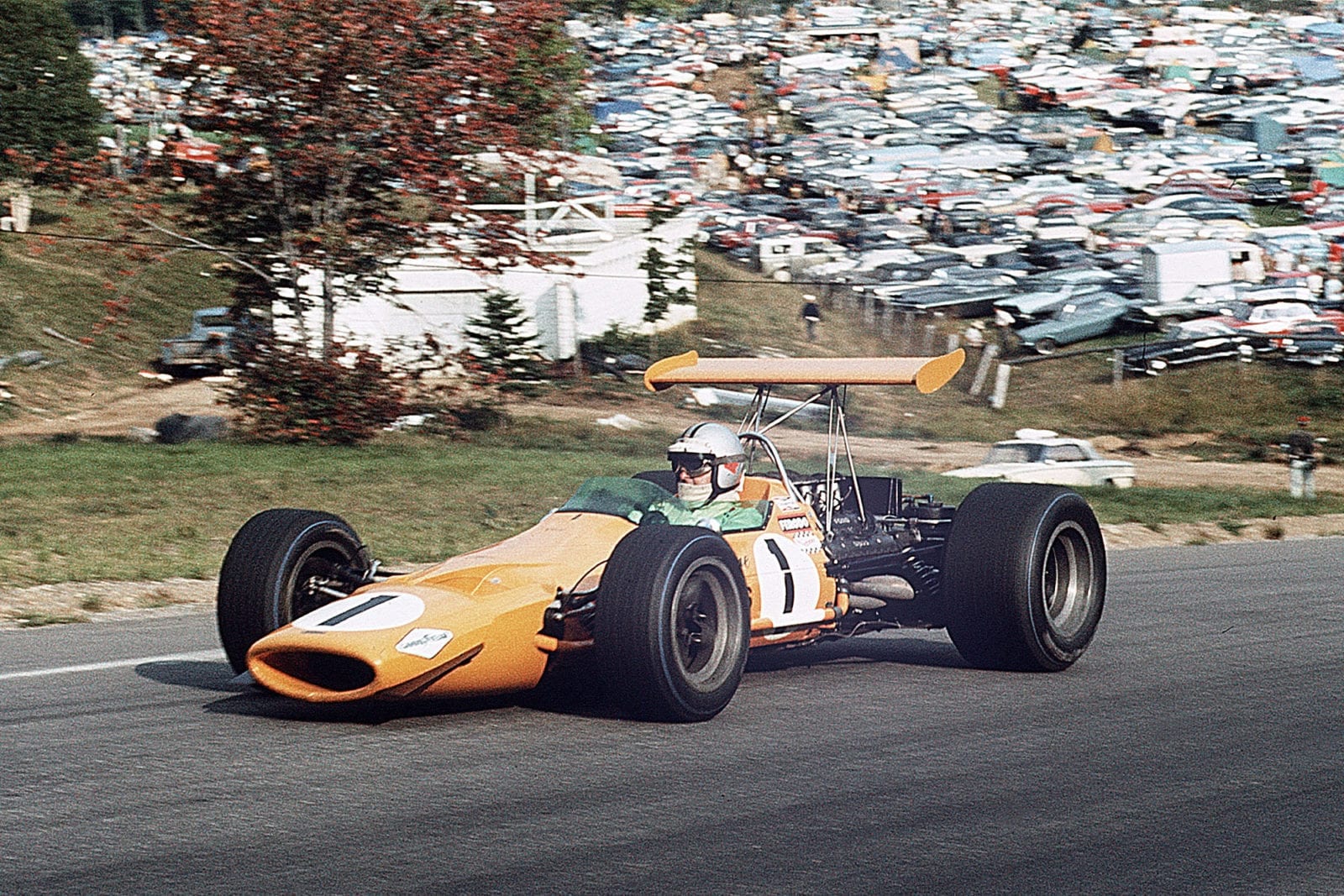
Denny Hulme secured victory in the McLaren-Ford
Motorsport Images
The first Canadian Grand Prix held last year at Mosport was sandwiched between the German Grand Prix and the Italian Grand Prix, which made travel arrangements rather difficult. This year the date of the race was moved to fall two weeks before the United States Grand Prix and the venue was changed to the 2.65-mile Mont Tremblant circuit, 60 miles north of Montreal.
The circuit is not very fast and is on the narrow side, and was surrounded by grassy banks and light bushy scrub with only the occasional barrier. However, after Bonnier had toured the circuit it became a little more like the twisty “tracks” that are creeping into Europe.
The GPDA bill came to 35,000 dollars, which was only 60% of their original demand, on a circuit which has seen racing almost as fast for several years. Banks were bull-dozed away, spin-off areas were created in the scrub land, making several sections of the road look similar to the old Casablanca circuit, which went into the desert.
Armco barriers and chain-link fences had sprouted and John Ross, the Clerk of the Course, could not explain the reasoning behind much of this spending of money but reckoned there would not be a race unless a minimum of work was done. Perhaps the GPDA ought to pay for these improvements, which would no doubt curb their future enthusiasm.
The lap record and fastest practice lap stood to Al Unser in a four-wheel-drive USAC Lola and Andretti in his USAC car at 1min 35.7sec. These times were set up only a few weeks ago and many Americans were watching with interest to see which class of racing was faster. With a race length of 238.5 miles, fuel capacity was a big point. Some drivers and teams wanted the race shortened but McLaren very sensibly refused to sign what had to be a unanimous petition to reduce the distance. It seems McLaren still enjoys racing for itself and not just for monetary gain.
The Ferrari team had three cars for Amon and Ickx. They were 0015 for Ickx and 0003 and 0009 for Amon. Due to the short time between the Italian Grand Prix and the air freight departure for Canada, little had been done in the way of development. On Ickx’s car the over-riding control switch to the hydraulically-operated wing was removed and this was now fully automatic. The wing was in the working position in 1st, 2nd and 3rd gear, also every time the brakes were applied in 4th and 5th gear. So the only time the wing feathered was when running in the two top gears. On Amon’s car the control switch could put it into working position at the driver’s discretion, whilst travelling fiat out in top or 4th gear. On this circuit, it was used at two points only for a total of about three seconds.
BRM brought one works car P133-01 for Rodriguez. The second BRM entry was the Parnell car for Courage, which was the same used at Monza, including the pannier tank for extra fuel. The Brabham team had two cars, BT26-1 for Brabham and BT26-3 for Rindt. The latter car was the spare at both Monza and the Nurburgring and raced for the first time at Oulton Park. Both cars were fitted with the double wings and the big hinged wing at the rear was fixed in one position and was not controlled by the driver. On Rindt’s car there were also nose spoilers fitted but these were removed when it was found that they affected the side extraction of air from behind the radiator with resultant high temperatures.
Team Lotus had three cars. For Hill there was 49B/6, now renumbered 8, this being the car which was crashed by Oliver at Rouen. The wing was a full width one, going out to the edge of the tyres. Oliver had 49B/2 with a medium-sized rear wing and, with Brack’s car, these were the only Cosworth-engined cars to be fitted with the new exhaust which gives 15 extra bhp at the top end of the rev limit but reduces the mid-range power which on this winding circuit is so important.
The third Lotus 49B/5 was for Bill Brack, a Canadian driver at present leading the Eastern Canada Formula Championship (F2 cars). He also happens to be the Lotus distributor for the whole of Canada. The Walker-Durlacher car for Siffert was the same 49B/7-fitted with the usual wing with its large HART SKI advertisement.
There were four McLarens, the two works cars for McLaren and Hulme, a third McLaren-Cosworth for Gurney and, of course, the McLaren-BRM for Bonnier. The latter was his usual M5A/1 which he drove into sixth place at Monza. The car Gurney was to drive was M7A/3 which has been bought with Cosworth engines by AAR for the three end-of-season races, as the Eagle is still not fully developed for racing. The two works cars M7A/1 and M7A/2 were as raced at Monza, less the new exhausts. Hulme, in an unofficial practice on Thursday, tried the new four-into-one exhausts but was not satisfied with them.
Coopers had two cars for Elford and Bianchi, F1-1-68 for the latter with a fixed wing and F1-4-68, with the spring-loaded wing which feathers as the speed increases, for Elford.
There were four Matras entered. Two Matra-Cosworths for Stewart and Servoz-Gavin, MS10-01 with its wing mounted direct onto the uprights for Stewart and MS10-02 with the chassis mounted wing for Servos-Gavin. Both cars had old exhausts, otherwise they were in Monza trim. The two Matra-entered cars, MS11-01 for Beltoise and MS11-03 for Pescarolo both had fixed wings, the electric solenoids having been removed. On Pescarolo’s car the old twelve pipes into six pipes exhaust system was fitted; these had been discarded after Monaco in favour of the twelve into four system.
Honda had two cars entered for Surtees, RA301/801 and RA301/802. 801 was the older car and had the widest wing, also the engine was fitted with an old exhaust system to try and get back some of the power which was missing at Monza. Surtees was complaining there was nothing over 10,000rpm.
Completing the field was Al Pease in his old Eagle (101) Climax 4-cylinder 2.7-litre car. This was in the same trim as it was for the last Canadian Grand Prix at Mosport.
Qualifying
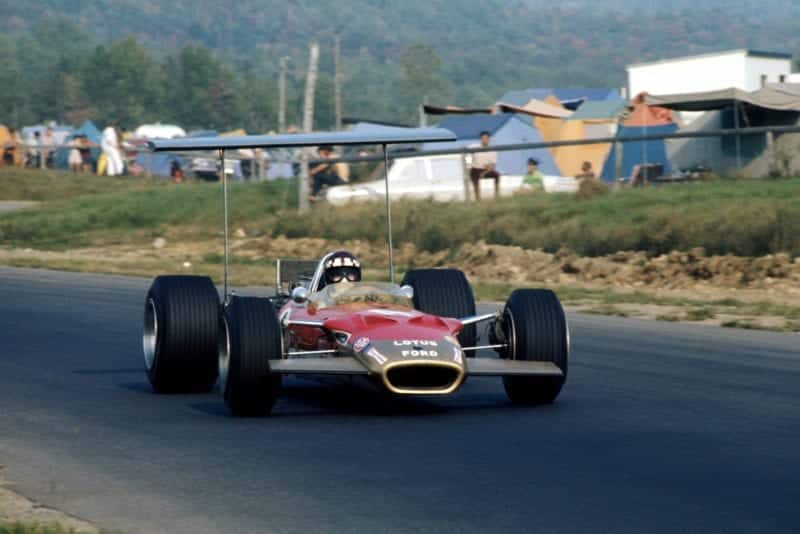
Jackie Oliver could only manage 9th on the grid for Lotus
Motorsport Images
In hot sunshine and with practice due to start at 1pm on Friday, all 22 cars were present and most of them ready to go out when the track was open for training. First away were Hulme, Surtees, McLaren and Courage, followed by most of the field. Hill and Stewart started to increase the pace after the first few laps and were soon being signalled 1min 38.5sec but in the first half hour it was Hulme and Rindt who were fastest with times of 1min 36.9sec each.
Rindt found the Brabham running too hot and as his car was fitted with front spoilers as well as the nose wing, it was assumed that the spoilers were disturbing the air exit from behind the radiator. To check this, spoilers were fitted to Brabham’s car, which was running at a normal temperature, while air extractors were made up to increase the draw from behind the radiator.
After the first rush of practice, several cars had intermediate gear ratios changed. Amon had the pedals moved in his car to the same position as the one he crashed at Monza. Gurney was trying a McLaren-Cosworth for the first time and there were certain minor fitting problems to be sorted out to make the cockpit comfortable for his large frame. Surtees was using the old car and was soon down into the 1min 36sec bracket. He then did two laps in the new car and came in to have the brakes bled and the tyres changed.
The first break in practice came when Elford went missing and the breakdown truck went to tow him in. The Cooper had stopped with fuel pressure trouble on the uphill section of the circuit. When the car reached the pits and the starter was pressed, all seemed normal as it burst into life, but within a moment the fuel pressure rose and the engine died. For the rest of the afternoon Coopers tried to find the exact trouble, without success, and finally it was assumed to be vaporisation.
With the resumption of practice, Hill became the first driver to put in a time of 1min 35.8sec, which was only one-tenth off the practice and race records. Siffert’s Lotus had scared him when the throttle had stuck open over one of the rises, but on checking the slides and everything else it seemed to be working quite freely. While the mechanics were working on this, they also changed the inlet trumpets for the ones used on the slow Jarama and Monaco circuits.
“It may have been the stiff throttle but for two laps Ickx looked a little wild, then he went missing and the ambulance went out after him”
The course record went to Amon first, then Surtees, Hill and Stewart in quick succession as they got into the lower 1min 35sec Surtees was still doing laps in the newer car but not very fast and he was concentrating on the old car. The two McLarens were not in their Monza form, with neither car getting below the record. Oliver was putting in a lot of laps and getting faster each time but by the end of practice he hadn’t reached below 1min 36sec. Both Brabhams were in the 1min 35sec bracket and reckoned there was some more yet, especially if the temperature was to drop a little.
Ickx, in the second Ferrari, had been getting faster and also complaining of a sticky throttle. It may have been the stiff throttle but for two laps he looked a little wild, then he went missing and the ambulance went out after him. On the downhill right-hander after passing the start-finish line, the throttle jammed wide open and he charged across the dusty spin-off area and over the bank, completely wrecking the car, and cleanly breaking his left leg above the ankle. The break was so clean that when put in plaster he was back in his hotel that evening.
While this panic was taking place and the track was closed, Rob Walker had a very nasty few minutes, for his car was 20 seconds overdue when the ambulance went out for lckx, and until an incoming car said who was off, he looked very worried. When Siffert did get back to the pits, it was with the throttle still jammed wide open and he drove in on the switches. It wasn’t the slides sticking, as in the case of Ickx, but the pedal had got underneath the stop and would not come back.
When practice was resumed Amon got down to 1min 34.7sec, but he said the circuit was slower than when he ran a Can-Am car here two years ago. Hill got the Lotus down to 1min 37.8sec before over-doing it on the same corner that Ickx crashed, and he finished up pressed hard against the bank with a buckled nose and left-hand front suspension. Stewart had looked fast on several occasions but was unable to get under 1min 35sec with Servoz-Gavin in the other Matra-Cosworth V8 3sec behind. Both BRM’s were short of power and were not in the running. The two Matras did little practice and their times were not competitive nor were the Coopers, who are suffering from the lack of development to the BRM engine.
The two Canadians were unable to get below 1min 40sec and Pease was only just able to break the 1min 50sec time.
For the second practice session the temperature had dropped a little and there was some cloud about. Hill’s car had been rebuilt overnight and the repaired nose was not on Brack’s car. Hill’s car was also fitted with a Hewland DG300 gearbox in place of the usual FG400. Ferrari had fitted a flanged external water pipe to Amon’s car to reduce temperature and stop the fuel lines from overheating and causing vaporisation. Coopers had re-organised their fuel system, having the mechanical and electric pump now in parallel instead of in series. Rindt had a new engine after a cam follower had broken up.
First out after a late start was Surtees and he completed several laps before Siffert, McLaren and Pease joined him. McLarens were trying new Goodyear G9 dry pattern tyres which have the Indy track-type tread and using the same compound that Hulme used to win at Mona. The Monza tyres are now known as the G9 intermediate. As the tread on the front dry tyres was an inch wider, this unbalanced the cars somewhat and so there was a switch to dry pattern rears and intermediate fronts. While Brabham was out trying tyres, the welding on a lower rear wishbone broke at the inner mounting point and he had to be towed in for a new one to be fitted.
There was no-one making very serious times in the first two hours as oil left from some local race practice was still about and any fast times would be made as the clouds came up and the air cooled. Stewart had reached his maximum the day before and on several occasions got to within a tenth of his time, but not below.
Siffert, however, was going well and was quickly under his previous day’s time when he roared past the pits on one occasion a cloud of smoke poured from the cockpit and worried mechanics waited to see what needed repairing, but all was well for it was only the fire extinguisher going off accidentally.
Surtees had a problem with his two Hondas—the new car was overheating and vaporising the fuel at such a rate that a fuel stop would be needed in the race, while the older car had a slightly cracked block, so he was in a quandary as to which to drive. His mind was made up for him when the newer car had a wishbone break on the fast part of the circuit. The chassis sat down in the road for a long way and when finally the Honda came to rest steaming and smoking, an enthusiastic fireman covered it in powder, which got right into the engine.
Tension began to grow as the last hour neared, for from the various preparations this was going to be the vital time for getting pole position and the BOAC trophy, plus 1,000 dollars. It is amazing what 1,000 dollars can do for the last hour was almost as exciting as the race. Siffert started the ball rolling with a time of 1min 34.5sec, which was equalled just afterwards by Gurney in the McLaren. Next, Hulme got under 1min 35sec but could not better 1min 34.9sec, a tenth faster than McLaren during the same period. When Oliver came in his sub-frame at the back of the engine was cracked where the upper link connects and the car was wheeled quickly away.
Rindt told his mechanics that now was the time to get under 1min 34sec and that is just what he did. In a series of very fast laps he reached 1min 33.8sec, which drew applause from everyone. Now all eyes were on Amon and Hill. Amon responded well and equalled Rindt’s time but Hill was not happy. Something was wrong with the back end and twice he came in to have it shaken and examined, but there seemed nothing wrong with it.
“Tension began to grow as the last hour neared, for from the various preparations this was going to be the vital time for getting pole position”
Hill’s time of 1min 35.9sec seemed disappointing until just as the flag went out it was found that Hill’s rear wheels and tyres were on Brack’s car and Brack had the wheels and tyres from Hill’s car. As the panic change took place, the flag went out and Hill managed to do one untimed lap by running over the flagman’s toes and getting out onto the circuit.
So practice ended and as it did, the heavens opened and with lightning flashing round the autumn-tinted hilltops the rain gave the track a real soaking. Al Pease stripped the Climax engine and found that the smoke which had been pouring from the exhausts throughout practice was more serious than he thought and the slowest car was withdrawn.
Race
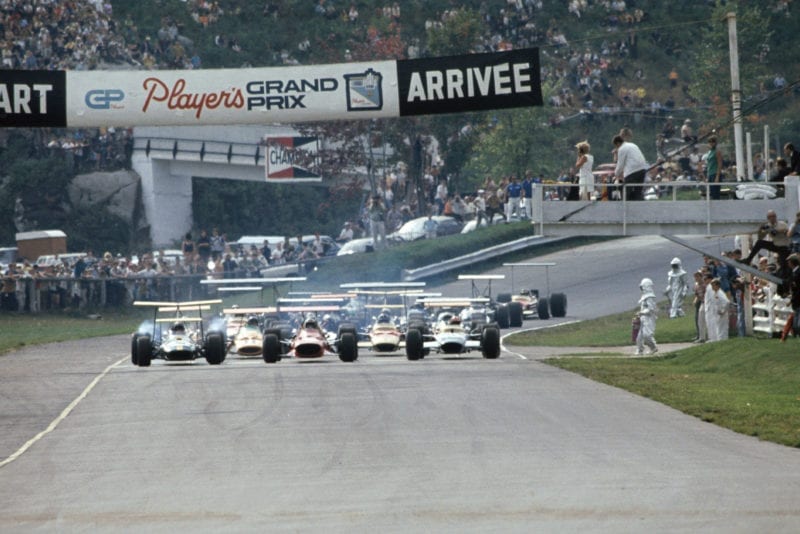
The race gets underway
Motorsport Images
Race day was dry and sunny with some towering banks of clouds which kept the tyre companies on their toes. All three Lotuses had strengthening plates welded on to the sub-frame at the point that Oliver’s had cracked. Final preparation for this race consisted of squeezing in as much fuel as possible. Certain drivers had asked for an acclimatisation session in advance of the warm-up lap and there was ten minutes put aside for this at 1pm. When Hill got back to the pits it was noticed that his drive shafts were slightly twisted. A look at Oliver’s and Brack’s confirmed that all three were like it and immediately the mechanics got to work to replace the twisted shaft with new ones.
It became noticeable that Bonnier’s car was being towed round and round the paddock and wasn’t bursting into life. When 2:30pm came the race should have started but the hangers-on in the pit road hadn’t been cleared and it was a further fifteen minutes before the Canadian Prime Minister dropped the flag.
Amon was leading into the first corner with a solid pack of cars right behind. From the “dummy grid” Bonnier’s car was pushed to the pits still with a dead engine. It was more than an hour later before the mechanics found a small Allen key sheared in the fuel metering drive.
“The pace was furious”
At the end of lap 1, the cars were in line ahead with Amon trying to hold Siffert off in the front. Third was Rindt, then Gurney, Hill, Hulme, McLaren, Brabham, Surtees, Rodriguez, Oliver, Stewart, Courage, Servos-Gavin, Beltoise, Bianchi, Brack, Elford and, last, Pescarolo.
The next lap saw little change except that the pace was furious. Brabham and Surtees swapped places, also Oliver and Stewart. By the third lap, the gaps were beginning to form. Amon and Siffert were nose to tail and then dropping back was Rindt, who seemed content to watch the two in front scrapping without getting too closely involved. A small gap was opening to the next group of seven led by Gurney, then Hill, Hulme, McLaren, Surtees, Brabham, Stewart. The rest were beginning to spread out.
For the next few laps the pressure was hardened and the order unchanged. By lap 5 there was five seconds between Rindt and the Gurney-led bunch. On this lap it was also noticeable that Siffert had oil smoke coming from the exhaust especially on corners. The speed was creeping up and on lap 8 Siffert broke Unser’s record. There was now two seconds between Siffert and Rindt and eight seconds to Gurney and his group.
The first car to go missing was Surtees on his 11th lap, when his gearbox broke up out on the circuit. This was the start of the retirements. Two laps later Stewart was missing and he came slowly to the pits with his left cantilever rocker arm split at the pivot point. After standing and looking at it for perhaps the equivalent of a lap, Tyrrell suddenly decided to remove the cracked arm and replace it, so Stewart lost eight laps but was out again in last place.
The leading order remained unchanged; Amon and Siffert pulled further ahead on their own. On lap 16 Bianchi made the first of six pit stops with chronic fuel starvation which was never properly cured, although the fuel supply system was torn apart and re-assembled.
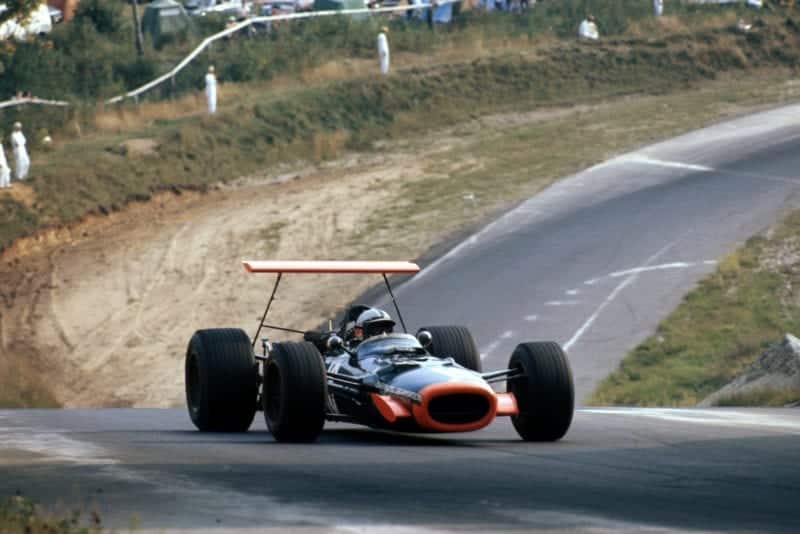
Rodriguez secured a podium place climbing from 12th at the start to an eventual 3rd
Motorsport Images
On the 18th lap, Siffert set a new record of 1min 35.2sec and still Amon was holding him off, although the Lotus nose was at times well up beside the Ferrari. Both leaders now seemed to be having some troubles. Amon had lost the use of his clutch on lap 12 when part of the centre broke, jamming the release mechanism, so while braking and changing down, Siffert was able to close right up on the Ferrari, but whilst accelerating away, the Ferrari was still able to pull clear. It was now noticed that even more smoke was pouring from Siffert’s tired engine. Rindt had dropped back now by eight seconds with Hill some 10 seconds behind him, then four seconds behind came Gurney, Hulme and McLaren in formation. As the 18th lap ended, Brack pulled into the pits very slowly, the drive shalt to the right wheel missing.
On lap 22, Siffert set another new record in his vain attempts to gel by Amon. His time of 1min 35.1sec, 100.32mph was to stand as the fastest lap for the day and was a new record for the circuit. Courage completed 22 laps, then stopped out on the course with his gearbox jammed in neutral. The 20 starters were now down to 16 and Hill now looked as though all was not well. The No 1 Lotus was not being thrown about quite so hard as usual and Hill was beginning to look around at the back end. Brabham also sounded in difficulties for as the Repco engine opened up it was making very tough noises.
As the leaders crossed the line on their 25th lap, there was 0.4sec between them. Then 11.6sec down came Rindt in a secure third his wings flapping merrily. Next, 13.6sec behind was Hill with the McLaren trio 6.6sec down and still in an orange bunch. Next was the rough-sounding Brabham, 7sec down with Oliver 16sec behind him. The only other cars on the same lap were Rodriguez and Servoz-Gavin. The rest of the field was now a lap down and were in the order Rodriguez, Servos-Gavin, Beltoise, Elford, Pescarolo and the last two several laps behind were Bianchi and Stewart.
At last, Siffert’s oil loss began to have its effect and he dropped back just a little each lap until on lap 29 he pulled into the pits and retired. A ring or rings were suspected as the reason for letting through the oil; in addition the left front tyre was almost bald and would not have lasted the race, and the drive shafts, which were slightly twisted at the start, were now badly twisted. As Siffert retired, Gurney had been passed by the two works McLarens and he was pointing at the front of the car. On his 29th lap he came into the pits with a stone-punctured radiator which had let all the water out.
Two laps later Brabham finally slowed, letting Oliver and Rodriguez by into sixth and seventh places and when the mechanics had a look at the Repco engine when it got to the pits, it was found that the flange studs had pulled, letting the left-hand exhaust fall off. Oliver’s sixth place was short-lived and, next lap, he went missing with his drive shaft sheared inside.
On lap 33, things again settled down for a few minutes with Amon 32sec clear of Rindt and, still keeping up the pace then 16sec down, came Hill, who was only 3sec ahead of Hulme, who was beginning to catch him. The only other cars on the same lap were McLaren, slip-streaming Hulme, Rodriguez and Servos-Gavin.
“Rindt’s was now the car that looked in difficulties for smoke was beginning to come from the engine”
Rindt’s was now the car that looked in difficulties for smoke was beginning to come from the engine. Beltoise made his first stop for a new battery, because his alternator was not working when the race began. On lap 38, Amon’s lead was 44sec and Rindt was obviously in trouble. Hill, however, was not closing on the Brabham and Hulme and McLaren were the same in formation just behind. As the cars completed their 39th lap, Rindt was no longer in second place and the Brabham rolled slowly into the pits with a very cooked engine. The oil pressure had gone down and the water temperature was off the clock. As Rindt retired, Servoz-Gavin was lapped, leaving only five cars on the same lap.
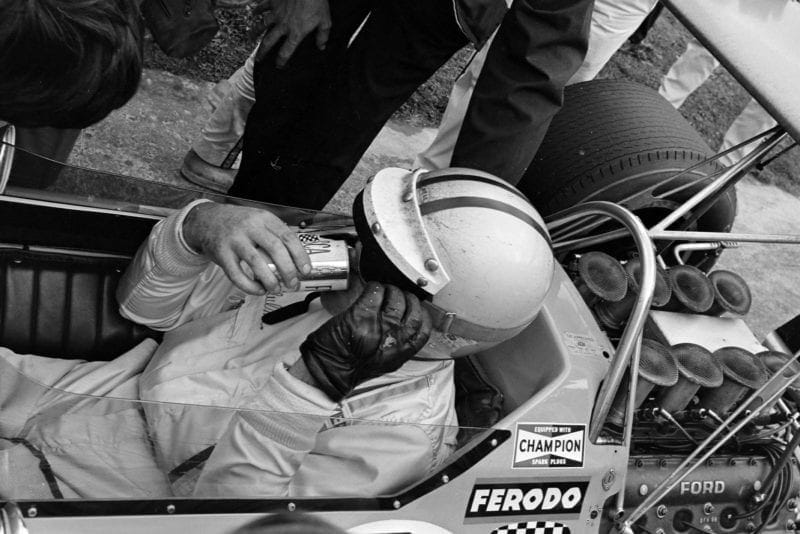
Denny Hulme accepts some well-earned refreshment at the finish
Motorsport Images
Hulme was now right up with Hill but still they were dropping back from Amon, the gap being 52sec on lap 41 and 62sec on lap 44. On this lap, Hulme made a big bid to get by Hill and as he got alongside in front of the pits Hill lifted right off, enabling McLaren to go past as well. At the half-way stage there were 11 cars still running with Amon still in a dominant position.
For the next to laps the position remained unchanged with Hill dropping back 20sec on the McLaren and only 4sec ahead of Rodriguez, whose BRM was now beginning to smoke badly. On his 55th Pescarolo vanished out on the circuit and when he later walked in, he reported his oil pressure had suddenly gone.
Next lap, Rodriguez was ahead of Hill, the Lotus came into the pits and the mechanics were looking for something broken or loose at the back end, which was causing vibration and jolting badly over the bumps. When they could find nothing, Hill went on his way but now even slower than before.
Ten cars were now still running although Bianchi was so many laps behind he could never qualify. On the 65th lap, Amon was over a minute ahead of Hulme, who was being shadowed by McLaren, then a lap behind was the sick BRM oil coming from the two left rear inlets and burning in clouds on the exhaust pipes. Next came Servoz-Gavin with Hill a lap behind. Elford was going consistently with Beltoise some laps behind, and last was Stewart, who was now going very fast and slowly catching up some of the lost ground.
At 71 laps it looked as if there would be a procession home when Servoz-Gavin went missing. He had spun and hit a bank and there was some doubt as to whether a puncture had caused him to spin, or the spin and subsequent thump against the bank had caused the puncture. Then drama; Amon pulled into the pit, the Ferrari final-drive pinion was almost smooth, caused by the continuous gear changing without the clutch. Poor Amon was consoled by Ickx, who was in the pits on crutches. It had seemed that at last Amon was going to get his win.
“At 71 laps it looked as if there would be a procession home when Servoz-Gavin went missing”
McLaren, summing up the situation from his pit signals, slowed right down and was finally lapped by Hulme, who went charging on to his second victory this year. Beltoise changed yet another battery before the end, then one lap later retired with a stripped gearbox.
Six cars finished the race. The McLaren team must have been very happy that they didn’t get enticed into signing the petition to shorten the race, and they have proved they are a strong, sound car by finishing as strong as they were at the start. Third was Rodriguez, who had slowed right down at the end to save the engine as much as possible. Hill and Elford were on the same lap, four laps behind, then seven laps down came Stewart, to complete the finishers.
When Hill’s car stopped at the pits the trouble was found. The tap engine mounts had given way and the car had jack-knifed until the engine was leaning on the back of the monocoque. When two mechanics either side lifted the centre of the car, it bent several inches in the other direction.
